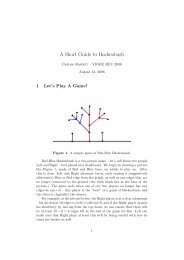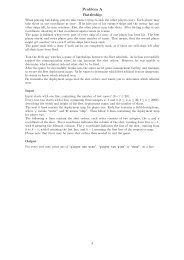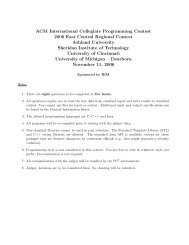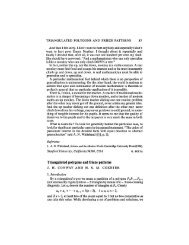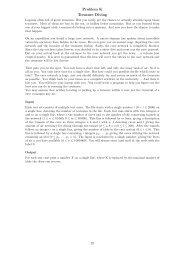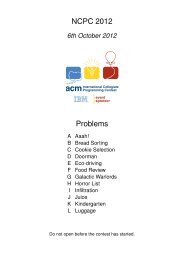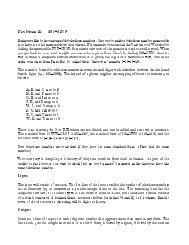Review1 of Liber De Ludo Aleae (Book on Games of Chance) by ...
Review1 of Liber De Ludo Aleae (Book on Games of Chance) by ...
Review1 of Liber De Ludo Aleae (Book on Games of Chance) by ...
Create successful ePaper yourself
Turn your PDF publications into a flip-book with our unique Google optimized e-Paper software.
thirteenth, calling king. Then, if in this entire sequence <str<strong>on</strong>g>of</str<strong>on</strong>g> cards he has<br />
not drawn any with the rank he has called, he pays what each <str<strong>on</strong>g>of</str<strong>on</strong>g> the<br />
players has staked and yields to the player <strong>on</strong> his right. But if in the<br />
sequence <str<strong>on</strong>g>of</str<strong>on</strong>g> thirteen cards, he happens to draw the card he calls, for<br />
example, drawing an ace as he calls <strong>on</strong>e, or a two as he calls two, or a<br />
three as he calls three, and so <strong>on</strong>, then he takes all the stakes and begins<br />
again as before, calling <strong>on</strong>e, then two, and so <strong>on</strong>…”<br />
Provisi<strong>on</strong> is made in the rules for a new deck <str<strong>on</strong>g>of</str<strong>on</strong>g> cards should the dealer use all the cards in the first set.<br />
The game <str<strong>on</strong>g>of</str<strong>on</strong>g> Thirteen provides an early example <str<strong>on</strong>g>of</str<strong>on</strong>g> a problem relating to coincidences or matches.<br />
M<strong>on</strong>tmort describes a method for computing the chance or expectati<strong>on</strong> <str<strong>on</strong>g>of</str<strong>on</strong>g> drawing a card matching the<br />
number called <strong>by</strong> the banker. Since the time <str<strong>on</strong>g>of</str<strong>on</strong>g> Cardano, questi<strong>on</strong>s relating to expectati<strong>on</strong> have been<br />
solved <strong>by</strong> enumerating the favourable cases and the total possible events. M<strong>on</strong>tmort observes:<br />
“Let the cards with which Peter plays be represented <strong>by</strong> a,b,c, d, etc… it<br />
must be noted that these letters do not always find their place in a<br />
manner useful to the banker. For example, a, b, c produces <strong>on</strong>ly <strong>on</strong>e to<br />
the pers<strong>on</strong> with the cards although each <str<strong>on</strong>g>of</str<strong>on</strong>g> these three letters is in its<br />
place. Likewise, b, a, c, d produces <strong>on</strong>ly <strong>on</strong>e win for Peter, although <str<strong>on</strong>g>of</str<strong>on</strong>g><br />
the letters c and d is in its place. The difficulty <str<strong>on</strong>g>of</str<strong>on</strong>g> this problem is in<br />
disentangling how many times each letter is in its place useful and how<br />
many times it is useless.”<br />
To solve the problem, M<strong>on</strong>tmort first c<strong>on</strong>siders a game with <strong>on</strong>ly two cards, an ace and a two. There is<br />
<strong>on</strong>ly <strong>on</strong>e way in which the banker can receive the proceeds <str<strong>on</strong>g>of</str<strong>on</strong>g> the wager, an ace has to be the first card.<br />
M<strong>on</strong>tmort then computes the expectati<strong>on</strong>, essentially an applicati<strong>on</strong> <str<strong>on</strong>g>of</str<strong>on</strong>g> Huygens' 3rd Propositi<strong>on</strong> in <str<strong>on</strong>g>De</str<strong>on</strong>g><br />
Ratiociniis. If the proceeds total A, then the banker's expectati<strong>on</strong> is (1 . A + 1 . 0) / 2 = 1/2 A.<br />
The next case c<strong>on</strong>sidered is a game with three cards, represented <strong>by</strong> the letters a,b,c. M<strong>on</strong>tmort observes<br />
that <str<strong>on</strong>g>of</str<strong>on</strong>g> the six possible combinati<strong>on</strong>s for the letters (representing the possible orders for dealing the cards),<br />
four are favourable to the banker (and two are not favourable):<br />
"...there are two with a in first place; there is <strong>on</strong>e with b in sec<strong>on</strong>d place,<br />
a not having been in first place; and <strong>on</strong>e where c is in third place, a not<br />
having been in first place and b not having been in sec<strong>on</strong>d place."<br />
It follows that the expectati<strong>on</strong> is (4 . A + 2 . 0) / 6 = 2/3 A.<br />
Similarly four and five card games are c<strong>on</strong>sidered, indicating the expectati<strong>on</strong>s as 5/8 A and 19/30 A,<br />
respectively. The expectati<strong>on</strong>s for games with <strong>on</strong>e to five cards allows M<strong>on</strong>tmort to suggest a formula for<br />
computing the banker's expectati<strong>on</strong> generally, in a recursive manner:<br />
[g(p-1)+d] / p<br />
where:<br />
p is the number <str<strong>on</strong>g>of</str<strong>on</strong>g> cards;<br />
g is the espectati<strong>on</strong> when there are p-1 cards, and<br />
d is the expectati<strong>on</strong> when there are p-2 cards.<br />
22




